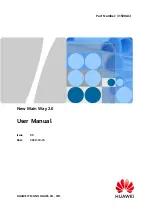
ADCP-90-606 • Rev C • May 2020
Page 45
© 2020
CommScope
. All Rights Reserved.
b. If the microcable is being routed to an NG4access universal panel shell mounted on a
non-NG4access frame, refer to the labels on the panel shell for instructions.
9. After connecting the connectors or cabled modules at the far end location, return to
to mount the Rapid Fiber panel shell on the equipment rack.
7.2
Microcable Pulled Through Conduit
Use this procedure to route the lead end of the microcable through conduit.
1. Route the microcable to the point where it will enter the conduit.
2. Insert the leading cable connector into a cable pulling swivel such as the one shown in
Figure 59. Insert Microcable Lead Connector into Pulling Eye
3. Wrap several layers of vinyl tape around the pulling swivel and the trailing connector as
Note:
Due to space constraints in conduit, only cables with MPO connectors or MPO-like
non-functional connectors should be routed through conduit.
Note:
The swivel will ensure that proper pulling force is applied to the cable and will
reduce the possibility of binding or tangling the cables within the conduit.
Note:
This will allow the connectors to slide smoothly within the conduit.
Caution:
Avoid using excessive force when unwinding microcable from the internal spool. If the
cable fails to unwind, check for obstacles or obstructions that would prevent the spool from
turning. The maximum recommended pull force that may be applied to the MPO connector
pulling eye, fanout assembly pulling sock stub connector pulling eye, or to the cable itself is 40
lbs. (18.14 kg)
. Use the hand-wrap method if pulling on the cable by hand.






































